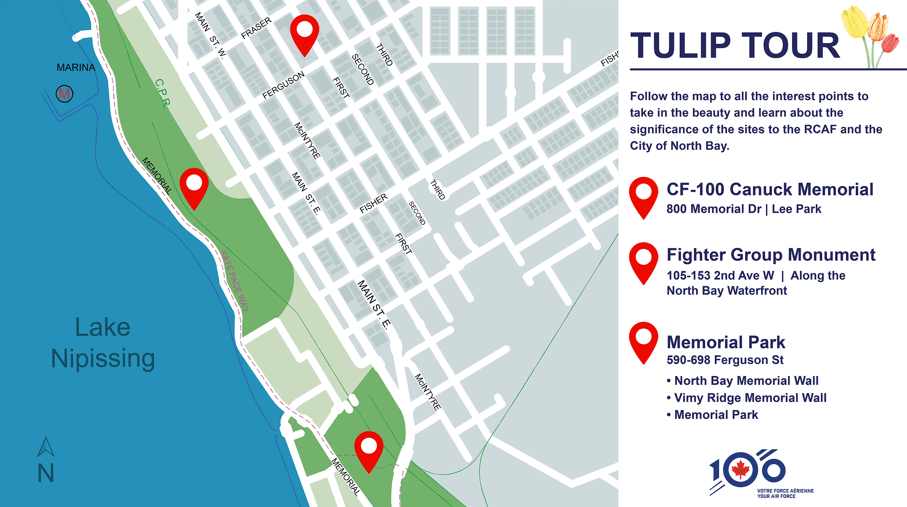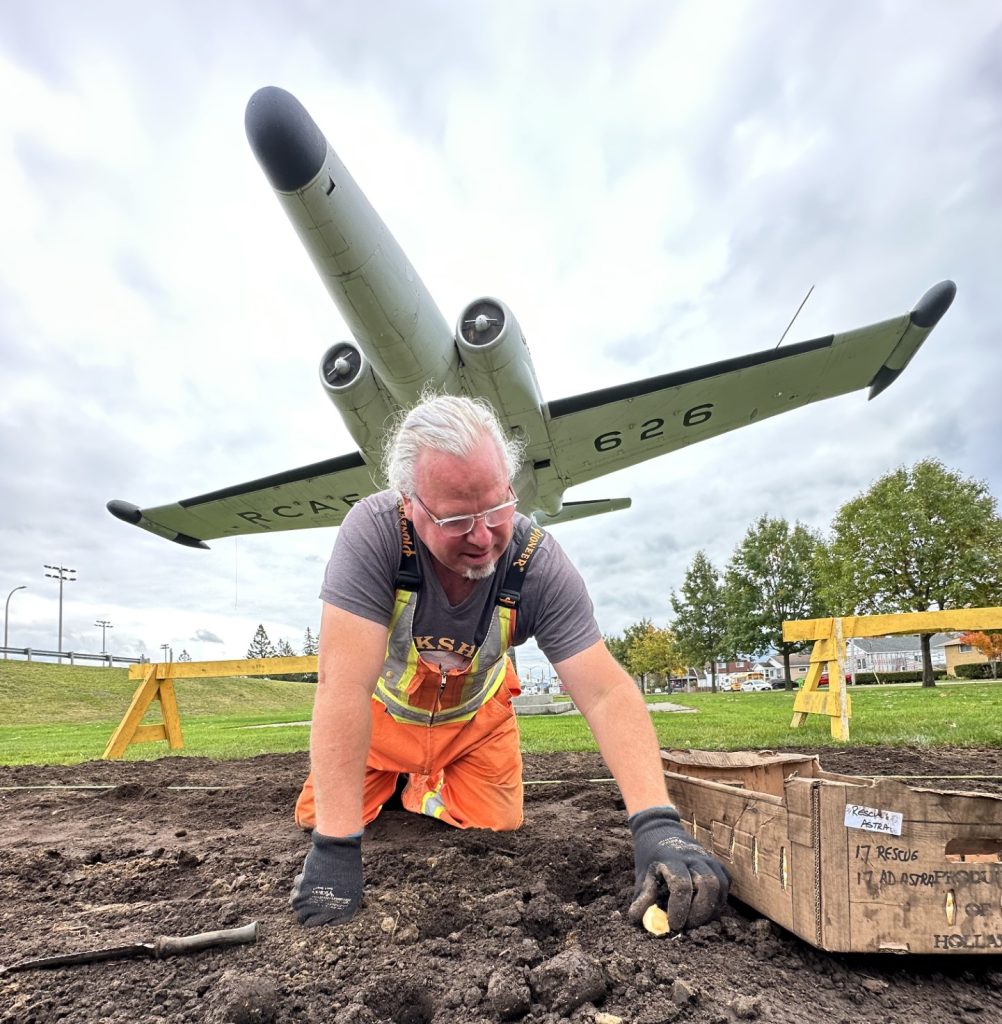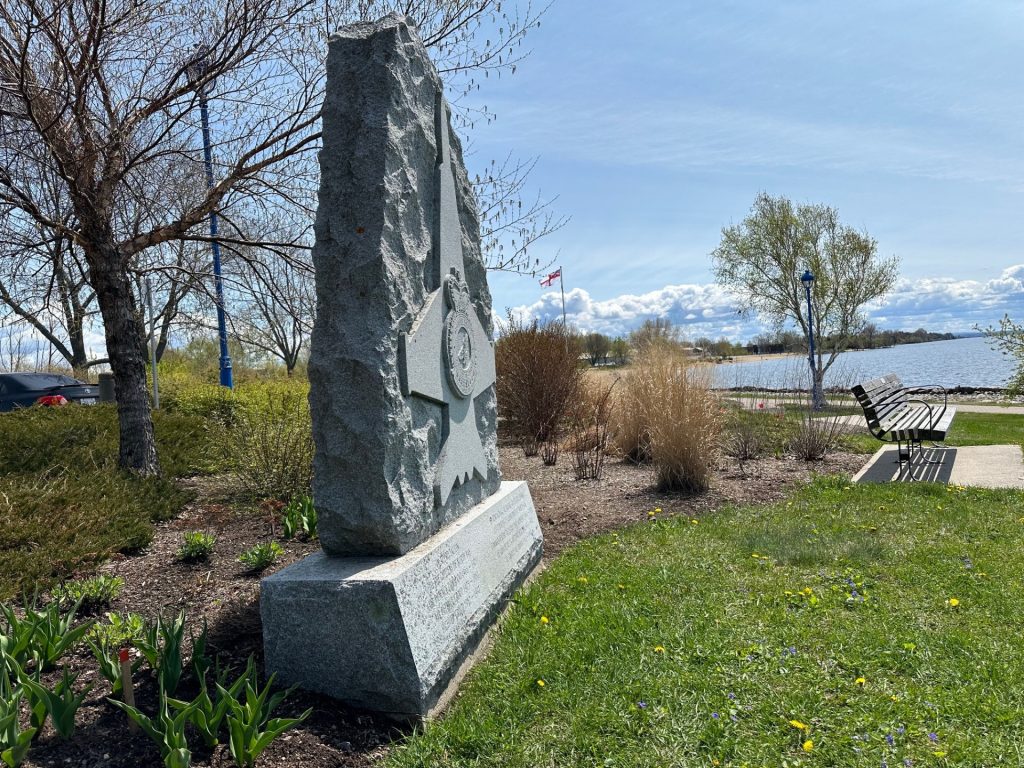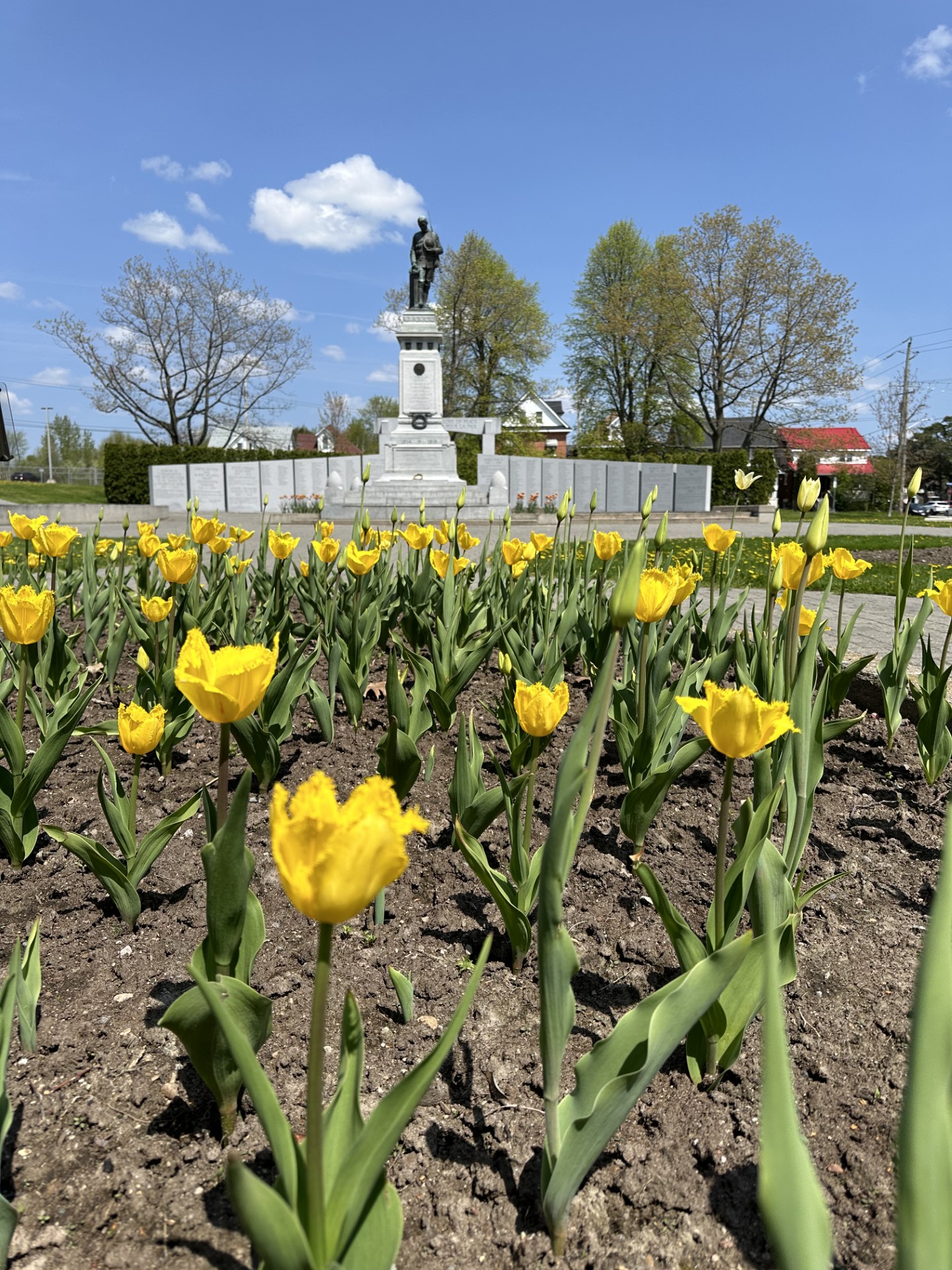Flight of Fancy Tulip Tour
In celebration of the Royal Canadian Air Force (RCAF) Centennial, the 22 Wing North Bay RCAF2024 Stakeholder Committee and the City of North Bay planted tulip bulbs in locations around North Bay that have special significance in the history of the RCAF. In order to recognize these efforts and celebrate this milestone, Tourism North Bay has created a Tulip Tour highlighting these sites.
The RCAF has historic ties to tulips. In World War II, Canada assisted in the liberation of the Netherlands. As a thank you, and a yearly tradition, to this day the Netherlands sends 20,000 tulip bulbs to Canada.
To view the newly planted tulip beds, visitors can follow the map (below) and take in the beauty at the following sites:

North Bay CF-100 Canuck Memorial at Lee Park
This memorial is dedicated to the men and women of 414 Squadron, 406 Wing, Royal Canadian Air Force and to the citizens of North Bay for their support. It was erected by 406 Wing, Royal Canadian Air Force Association.
The CF-100 was erected by 406 Wing, Royal Canadian Air Force Association, and dedicated to the memory of their comrades who gave their lives in the service of their country.
The CF-100 CANUCK was conceived to meet the demanding requirements of defending a country as vast as Canada. It was a two-crew all weather high-altitude long-range interceptor built in Canada. It first flew on January 19, 1950, and the first were delivered to the RCAF operational training unit North Bay in July 1952. There were 9 squadrons based in Canada, 4 based in Europe, and 3 based in Belgium. A total of 692 CF-100s were built.
North Bay’s fighter unit, 445 Squadron, was the first in the world armed with the Avro CF-100 Canuck interceptor. The CF-100 was one of two combat aircraft designed and built entirely in Canada, and the only one to enter air force service. It had the ability to hunt other aircraft in any weather, night or day, making the CF-100 the preeminent interceptor among global air forces when it began service with the Royal Canadian Air Force in 1952. In North Bay, 419, 433 and 414 Squadrons also flew CF-100 interceptors. CF-100s also flew with the RCAF in Europe on NATO deployments.
To honour the aviators who served and continue to serve in the RCAF, the RCAF flag flies at Lee Park a few meters away from the CF-100 Canuck memorial site.

Fighter Group Monument along the NORTH BAY WATERFRONT
Fighter Group (FG) was formed on July 15, 1982, out of Air Defence Group (ADG) at Canadian Forces Base (CFB) North Bay. The ADG was responsible for air defence and air sovereignty which had been previously assigned to Air Defence Group. FG also took on the Canadair CF-5 tactical fighter which had previously been assigned to 10 Tactical Air Group (Force Mobile Command later re-named Land Force Command) based at CFB St. Hubert, Quebec. All fighters were now under one unified command. Fighter Group also provided tactical fighter support to NATO’s Northern Flank, to Force Mobile Command and Maritime Command in Canada.
At the same time as the new CF-18 Hornets were arriving to Canadian fighter bases, NORAD regional boundaries were reorganized to coincide with the new technology/second generation equipment in the Underground Complex. Whereas the original Semi-Automatic Ground Environment or SAGE computer system only had the capability to monitor part of Canadian airspace and American sectors monitored the rest, the conversion to the Regional Operations Control Centre or ROCC computer system in 1983 meant that all Canadian airspace was now monitored from the one central location – North Bay. Because air defence and fighter aircraft go hand in hand, the Fighter Group/Canadian NORAD Region headquarters also rested here in North Bay.
As the world changed after the end of the Cold War, it was clear that the operational oversight of fighter operations did not need to be here in North Bay, and as 1 Canadian Air Division was standing up in Winnipeg as the national operational level headquarters for the Air Force, Fighter Group was absorbed into that organization in June 1997.
Source: Bethany Aitchison, Curator at the Canadian Forces Museum of Aerospace Defence, and Chris Charland.

Memorial Park
This memorial was unveiled on September 17, 1922, and constructed in memory of those men and women of the North Bay area who served, fought and died in the First World War. It was subsequently dedicated to those who served, and died in action, during Second World War and the Korean War.
The bronze statue is 8′ 6″ high, and the entire memorial is 26′ 6″ tall. Before the memorial was erected, the park was donated by the local school and trees were planted, dedicated to the names of the dead from the Great War. The statue was first used for Armistice Day ceremonies in 1922. The memorial was designed by C.D. McKenzie and constructed by Andrew Craig of North Bay and the McIntosh Granite Company of Toronto.
Memorial Park was officially named and dedicated at the Armistice Day ceremonies on November 11, 1923. In the summer of 1923, sidewalks were installed in Memorial Park and trees were donated by Senator Gordon of North Bay to beautify the park.
December 1918 – Idea of War Memorial proposed. Municipal Park and trees dedicated to individuals killed in the war. March 3, 1919 – Money was raised by public subscription and grants from Council. The plan for the monument and park was submitted by the Agricultural and Parks Committee. August 30, 1920 – Soldiers’ Memorial Fund was created. It started with $200 from license fees from the circus and 20% of license fees and fines from the town. The Great War Veterans’ Association were to oversee the funds.
December 15, 1920 – Children in the schools voted on the form of the War Memorial. May 1922 – By-law passed for purchase of park land. June 1922 – Normal school block selected for park. September 17, 1922 – War Memorial dedicated by Henry Cockshutt; later, mayor of Toronto.
According to The Nugget, September 18, 1922: This is a statue of a Canadian soldier standing with his head bowed, laurel wreath caught in right hand. This was the largest bronze statue ever cast in Canada up to that time. Measurements 26′ 6″ from base to top of monument. Base of monument is 8′ 6″ x 8′ 6″ x 3′ 2″. Statue is also 8′ 6″ high. Designed by C.D. McKenzie, sculptor, of Toronto. Contractors were Andrew Craig of North Bay and the McIntosh Granite Co. of Toronto. Construction entirely Canadian. Cost was $15,500.
THE NORTH BAY MEMORIAL WALL
This memorial was unveiled on September 17, 1922, and constructed in memory of those men and women of the North Bay area who served, fought and died in the First World War. It was subsequently dedicated to those who served, and died in action, during Second World War and the Korean War.
The bronze statue is 8′ 6″ high, and the entire memorial is 26′ 6″ tall. Before the memorial was erected, the park was donated by the local school and trees were planted, dedicated to the names of the dead from the Great War. The statue was first used for Armistice Day ceremonies in 1922. The memorial was designed by C.D. McKenzie and constructed by Andrew Craig of North Bay and the McIntosh Granite Company of Toronto.
The North Bay Memorial Wall was erected in 2000. It sits behind the North Bay Cenotaph and list the names of 636 men and women from the North Bay area who served and died in conflicts in the 20th century. Historical information of each conflict is carved into the wall. The wall is 70′ long, with an archway in the middle to access the Memorial Gardens and Field of Honour.
The Memorial Arch and Wall is dedicated to the war dead from North Bay. It was erected by Project Flanders Committee (Royal Canadian Legion Branches 23 and 599). The Committee is the product of all 11 Royal Canadian Legion Branches in the North Bay area and 25 Municipal and First Nations of the area.
Architects were Critchley, Delean, Trussler, Evans and Bertrand of North Bay. Research – Chairman Edmond V. Nicholson CD. Photograph – Kevin Scully. Contractors were GAP Construction Co Ltd. North Bay and Signature Memorials, Orillia Ontario. The project was overseen by Project Flanders Committee of the Royal Canadian Legion Branches 23 and 599. Branch 23 is located next door to the Memorial .
Vimy Ridge Memorial Wall
This memorial was unveiled on September 17, 1922, and constructed in memory of those men and women of the North Bay area who served, fought and died in the First World War. It was subsequently dedicated to those who served, and died in action, during Second World War and the Korean War.
The bronze statue is 8′ 6″ high, and the entire memorial is 26′ 6″ tall. Before the memorial was erected, the park was donated by the local school and trees were planted, dedicated to the names of the dead from the Great War. The statue was first used for Armistice Day ceremonies in 1922. The memorial was designed by C.D. McKenzie and constructed by Andrew Craig of North Bay and the McIntosh Granite Company of Toronto.
The Vimy Ridge Memorial Wall was dedicated in November, 2000. It has individual plaques for each soldier from this district who was lost in the battle. A smaller wall gives a brief history of the battle and acknowledges the generous sponsors of Project Flanders.
The plaques used to assign a particular tree to a specific fallen soldier on Memorial Drive were taken out of storage and placed on Vimy Ridge Memorial Wall.
To learn more about Canada’s historical and current contributions to air defence, visitors can also visit the Canadian Forces Museum of Aerospace Defence (CFMAD)
Read the full media release here!

